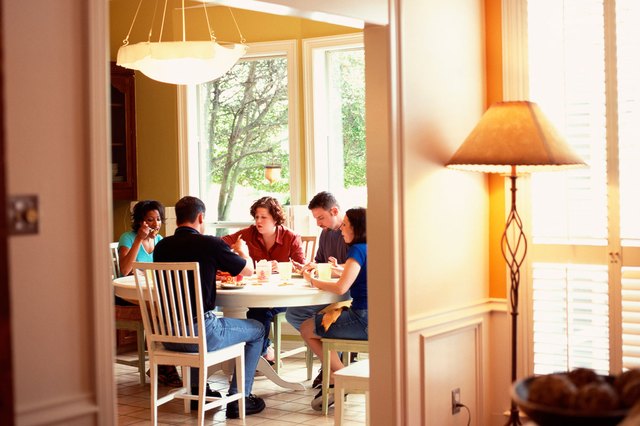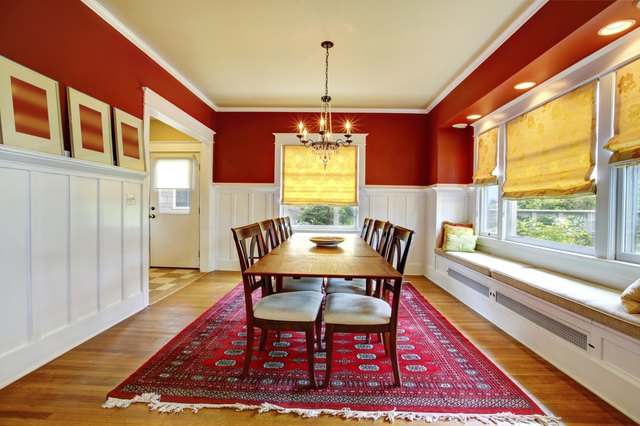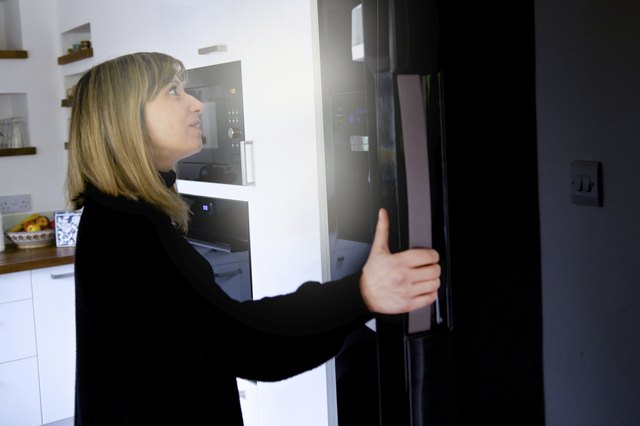11 ways to get fat
Advertisements

Advertisements
if your diet is abnormal the moment you walk into the front door, your house may be the culprit, not you. Research shows how your house is organized and decorated, which will guide your eating behavior - whether it's grabbing an apple when you're hungry or flipping through a bag of chips while watching TV. " "Our home can be designed to keep us healthy or to make us fat," said Dr. Brian Wansink, director of Cornell food and brand laboratory at Cornell University and author of slim by design: mindless eating solutions for daily life. Here are 10 ways to keep your home from damaging your healthy diet.
Credit: hero picture / hero picture / Getty picture Credit: Mint picture / Mint picture RF / Getty picture bright light will make you have the mood of overeating. In fact, in a psychological report study, people who ate in bright rooms ate 18 percent more calories than those who ate in the same room with dim lights. Get this: although they eat less food, they think it's better. Researchers think this may be because the dark environment calms you down and slows you down so you have a chance to realize that you're full - stop eating before you clean your plate and ask for a few seconds. Dr. Christopher ochner, a US ANA and weight loss expert at Mount Sinai Hospital in New York, suggests that, despite the importance of relaxing the environment. If you decide to relax on the sofa and have a meal in front of the TV, this strategy can have a lot of negative effects. Credit: create as / create as / Getty Images "red actually triggers brain chemicals that promote hunger," said Dr. Christopher oxner, a nutrition and weight loss expert at Mount Sinai Hospital in New York. If you have a red wall in your home, especially in the kitchen, you should consider painting it blue or green, says Dr. coral Arvon, director of behavioral health and health at the Pritikin Longevity Center in Florida. Both blue and green encourage relaxation so that you don't rush to eat, or worry, so that you stop eating when you're full. In a "contract magazine" experiment, people who ate in a blue room ate 33 percent fewer calories than those who ate in a yellow or red room. Your plate is very big the bigger your plate, the bigger your appetite. Research from Cornell University's food and brand lab shows that the size of bowls and plates can unconsciously guide how much you should eat. For example, when Chinese buffet diners go to the big plate buffet table, they provide 52% more food and 45% more food for themselves than those who use small plates. Dr. Brian Wansink, director of the food and brand lab, advises against using any plate larger than 10 inches. Even if you put the same amount of food on a 9-inch plate, like a 12 inch plate, the 9-inch plate will look more crowded and make you more satisfied with your food. Credit: Stockbyte / Stockbyte / Getty Images Credit: monkeybusinessimages / iStock / Getty Images Credit: boggy22 / iStock / Getty Images integral: robinimages / iStock / Getty Images Credit: monkeybusinessimages / iStock / Getty Images Credit: Warren Goldwyn / iStock / Getty Images Advertisements 1. Your house is dusty. It's better to clean it, because the dust may be the cause of your weight gain. A Duke University study has revealed how endocrine damaging chemicals (EDCs) in indoor dust can make you fat by affecting your metabolism and fat production. According to the study's researcher, Dr Heather Stapleton, a mixture of these chemicals in indoor dust promotes the accumulation of triglycerides and fat cells. "Studies have shown that as long as you are exposed to dust in EDC - even at relatively low levels - your body is stimulated to accumulate fat in the form of triglycerides. Too much triglyceride can lead to a higher risk of heart disease and stroke. Now listen to how to calm down in 3 minutes. Credit: choreographer / iStock / gettyimages
2. Your kitchen chair is too comfortable. The kitchen is the center of most families. We went out with our friends, sat down to pay the bills, and helped the children with their homework. 'at least in families that encourage binge eating,' said Brian Wansink, PhD, director of the food and brand laboratory at Cornell University. The more time you spend in the kitchen, the more you eat, "he said. And since most people don't just stand around the kitchen for hours in a row, replacing a chair with a slightly uncomfortable one can help you stay away from the kitchen. Wansink points out that when people sit in a mattess chair in the kitchen, they spend an average of 18 minutes less time in the kitchen than when they sit on a tufted mat.
your light has no dimmer switch

4. Your home is a mess. The most important way to keep your home healthy is to reduce clutter. This includes everything from the closet to the bathroom, "said Dr. coral Arvon, director of behavioral health and wellness at Pritikin's Longevity Center. Research after research shows that people who can lose weight tend to keep a clean and tidy home. " For example, in a study at the University of Minnesota, researchers let people wander around in messy or tidy rooms and then provide them with snacks. Of the participants who decided to eat snacks, 67% chose apples, while 80% chose chocolate. " A clean home will encourage you to have clearer ideas and better decisions. Your home is a mirror of your lifestyle. If your shoes fall out of the closet, I won't be surprised if you make an unhealthy diet decision. Your walls are red

7. "People tend to eat anything that's easy to get," said Dr. Christopher oxner, a nutrition expert at USANA and a weight loss expert at Mount Sinai Hospital in New York. For example, the average person who lives in a place where breakfast cereal is not at home (such as on the counter or on the top of the refrigerator) weighs 21 pounds more than the person who lives in the house, where you actually need to open the cupboard door to fix the cereal. " Dr. Brian Wansink, author of slim by design: an unconscious Diet Solution for everyday life, said: "people will say, 'Gee, I'm a little hungry' and then eat oneTurn the cereal. In addition, because of the healthy aura of oatmeal, it's easy to turn a handful of oatmeal into a dozen extra calories and 500 calories a day, he said.
8. According to a 2015 study by the University of Vermont, women who regularly watch cooking shows have a higher BMI for recipes from cooking shows, averaging 10 pounds more than women who get recipes from family, friends, magazines or cooking classes. According to the researchers, this is because many of the recipes shown on TV are not very healthy and often have too much food. So when you make food, you eat too much. In addition, even if you don't make decadent desserts on TV, food porn can psychologically motivate you to crave unhealthy food, said Dr. Brian Wansink, author of slim by design: mindless eating solutions for everyday life. Stick to foods that emphasize healthy tastes.
9. Willow jarosh, M.S., RD, a C & J nutrition nutritionist and spokesman for crisp tools in New York, suggests that TV with the table facing you should not be used in your kitchen, restaurant or any place where your family eats. Watching TV on a smartphone or tablet or interacting with technology at the table can lead to unconscious eating and dissatisfaction with a meal, which can lead to overeating later. " In 2013, a review published in the American Journal of clinical nutrition found that multitasking in a meal, whether watching TV or working on a computer, will moderately increase the food intake of a meal, and have a greater impact on the food intake in the rest of the day.
10. Fruits and vegetables are stored in crisper drawers, designed to make your products fresher. But in the end, they will only make you forget the vegetables you bought. " Instead, put fruits and vegetables in a nice glass bowl, so you're more likely to choose healthier foods. So you don't waste them, because if you put them in the fridge, you forget about them and they go bad, which is a bigger waste, "said Dr. coral Arvon, director of behavioral health and wellness at Pritikin Longevity Center. After all, according to research from Cornell University, you're nearly three times more likely to eat healthy food if you're in your line of sight. Meanwhile, willow jarosh, M.S., RD, a C & J nutritionist in New York City, said, "you can put the rest of your healthy food on the top shelf of the refrigerator, in front of the cabinet, in clean containers." Dr. Christopher oxner, a nutritionist and weight-loss expert at USANA, said that putting biscuits on the counter and spending them from time to time can help you stay on track for a long time, but if you put those spendthrift things where they are easy to see and get, they are more likely to become a full carnival. At Mount Sinai Hospital in New York. For example, in an International Journal of obesity research, people eat an average of 7.7 chocolates a day when they are in a transparent container on the table; 4.6 chocolates are in an opaque container on the table; 5.6 chocolates are in a transparent container six feet away; 3.1 when they are in an opaque container six feet away.
What do you think? Are there any of these food cheaters in your family? How do you keep healthy at home? Please leave a message below and let us know.














